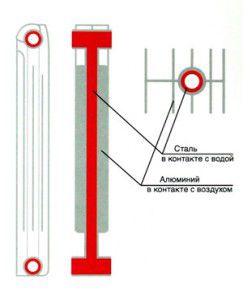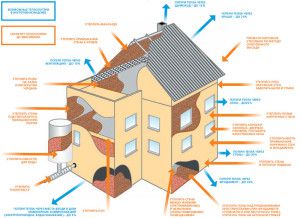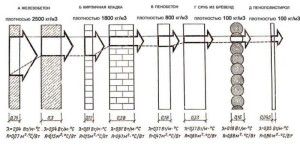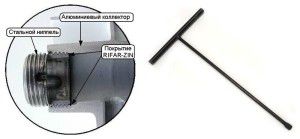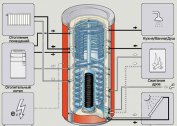Is it possible to independently change the configuration of the radiator, increase or decrease its heat transfer? This problem is solved if you first understand the design. Therefore, you need to find out the specifics of each type of heating radiator section: quantity calculation, assembly instructions and operational properties.
Design features of radiators
Before assembling the sections of the heating radiator, you should find out the structural features of this heating element. Its main task is the transfer of thermal energy from the coolant to the room. Therefore, it should have a large heating area.
Inside there are 2 channels through which hot water flows. From them, heat is transferred to the surface of the battery. According to this principle, aluminum, cast iron and bimetallic models are made. Steel most often have a non-separable case.
How to calculate the number of sections of heating radiators and what should be taken into account?
- Heat loss in the room. They will determine the necessary heating energy to compensate and maintain a comfortable temperature;
- Section Specific Power. It depends on the material of manufacture, dimensions of the structure and should be indicated by the manufacturer;
- Thermal mode of heating. For low temperature, it is not recommended to set the maximum number of sections in the heating radiator. This can lead to a decrease in water heating and thermal imbalance in the following areas.
When choosing a manufacturing material, it is necessary to consider not only the performance of radiators, but also the possibility of independent installation (dismantling) of sections. At home, this can only be done with aluminum and bimetal models.
There are non-separable types of sectional radiators. Their channel is an all-metal pipe. It is impossible to change their sizes.
Calculation of the number of sections for heating radiators
Correct calculation of sections of bimetal heating radiators begins with an analysis of the room where they will be installed. Its basis is the calculation of heat loss in the house. Most of them occur through walls and windows.
They should become the basis for calculating the number of sections of a heating radiator per room. Comfortable temperature in the room should be 18-22 ° С. Based on this, the thermal mode of heating is selected, and as a result - the parameters of the batteries.
It is recommended that you first insulate the outer walls, and then choose batteries based on the characteristics of the building's insulation.
Approximate calculation
The material of the manufacture of walls and the characteristics of insulation are not always known. In this case, an approximate calculation is made of the number of sections of cast-iron heating radiators. To do this, you can use two methods:
- On 10 m² of area 1 kW of thermal energy is needed;
- For 1 m³ of room volume, the heating system should generate 34 watts.
As an example, we can calculate the number of sections of heating radiators for a room of 20 m² with a standard ceiling height of 2.55 m. In this case, the total volume will be 51 m³. Suppose that the thermal efficiency of one section is 160 watts. We calculate their number:
- By area - 20 m² * 0.1 kW / 0.16 kW = 12.5 or 13 sections;
- By volume - 51 * 0.34 = 17.
As can be seen, when calculating according to the latest technique, the number of sections is significantly larger. This is due to regulatory requirements.
Accurate calculation
To accurately calculate the maximum number of sections in a heating radiator, you need to operate with the thermal conductivity of the materials. This indicator determines how much heat will leave the room through the walls.
First, the total area of the outer walls and separately the window structures is calculated. Suppose the former occupy 2.55 * 5 = 12.75 m². The total area of the window is 3 m². Then, to calculate the sections of bimetal heating radiators, we find out what materials were used in the construction of the house. Most often it is a building brick, the thermal conductivity of which is 0.16 W / m * C.
But for the correct calculation of the number of sections of the heating radiator in the room, you should find out the wall thickness. This is necessary to calculate the heat transfer resistance - the coefficient of inverse thermal conductivity. The average thickness of the supporting structures is 0.6 m.
We calculate the heat transfer resistance for 1 m²:
0.6 / 0.16 = 3.75 m² * s / W
Based on this, the heat loss for the wall will be:
(1 / 3.75) * 12.75 = 3.4 kV
Using the same principle, we calculate the heat loss through window structures, taking the average value of the heat transfer resistance of 0.9 per 1 m²:
(1 / 1.9) * 3 = 1.57 kW
The resulting heat loss in this case will be 3.4 + 1.57 = 5 kW. This figure should be taken as the basis for the correct calculation of the number of sections of cast-iron heating radiators for which the specific heat output is on average 200 W:
5 / 0.20 = 25 sections
This amount is not overstated, since according to the source data the wall is not insulated. If you install at least 100 mm of expanded polystyrene on the outer wall, then the estimated number of sections of heating radiators will be significantly reduced. The heat transfer coefficient of expanded polystyrene is 0.015 W / m * s. Then the heat loss will consist of the sum of the heat transfer resistance of the walls and insulation:
(0.6 / 0.16) + (0.1 / 0.015) = 10.41 m² * s / W
(1/10,41)*12,75=1,22
1.22 + 1.57 = 2.77 kW
2.77 / 0.2 = 14 sections
As can be seen from the calculation of the maximum number of sections in a heating radiator - even a relatively small insulation significantly reduces the heat loss of the room.
In addition to walls and window structures, heat loss through the ceiling and floor must be considered. This is especially important for the first floors of private houses without a basement.
DIY radiator assembly
Having performed the calculation of the sections of bimetallic heating radiators, you can begin to assemble them. If possible, it is best to entrust this work to professionals. Most often, trading companies provide this service.
For self-assembly of the heating radiator section, a special key is required. If this event is a one-time event, it is best to rent it. In each channel of the battery there should be a thread on which the nipple is wound - a steel pipe. Valley key rod allows you to collect radiators with the number of sections up to 7.
The direction of the thread in the nipple is different. Those. To connect the heating radiator section, it is enough to install it in the mounting groove and tighten it with a key. After the final assembly, the tightness of the structure is checked and pressure testing is mandatory.
The video material describes in detail the specifics of the installation of sections of radiators:
